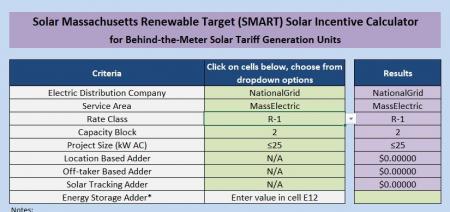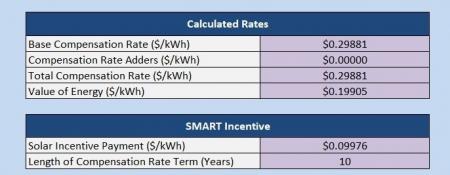
Calculating SMART Incentives for New Residential Solar Photovoltaic Arrays
This is one of a series of fact sheets designed to help Massachusetts residents incorporate energy efficiency and renewable energy into their day-to-day lives. For more information, see our Resources for Residents.
Solar photovoltaic (PV) panels can generate renewable electricity for your home, while providing you with significant energy cost savings. This fact sheet provides a guide to calculating incentives available for residential solar PV systems through the Solar Massachusetts Renewable Target (SMART) program. For general information on purchasing a residential-scale solar PV array for your property, see Considering a Solar Photovoltaic Array for Your Home on our website.
SMART Program Incentives for Small Systems
The Solar Massachusetts Renewable Target (SMART) program is a new program which will regulate incentives associated with production of electricity from new solar PV facilities in Massachusetts. The program is expected to begin in late 2018, once the Department of Public Utilities (DPU) has reviewed and approved the regulation, which has already been finalized by the Massachusetts Department of Energy Resources (MA DOER). Under the SMART program, residents and businesses can qualify to receive incentives for solar PV installations in the form of what are known as “tariffs,” which are credits that appear on the electricity bill of the system owner. For small residential PV systems (≤ 25 kW in capacity), the program provides a fixed credit for every kilowatt-hour (kWh) of electricity that is generated by the system for a period of 10 years.
This fact sheet addresses calculating SMART incentives for small solar PV systems (capacity ≤ 10 kW) associated with residential buildings. If your system is larger than 25 kW, or is a stand-alone facility that has no associated electricity load, see our general guidance on using the SMART calculator.
The SMART Incentive Calculator
A SMART incentive calculator is available as an Excel spreadsheet on the MA SMART program website. Click on the Resources tab, and scroll down to the section labeled “Workbooks.” The first file, labeled SMART BTM Value of Energy Workbook (5.1.18), is the calculator. It will download as an Excel spreadsheet. The image below shows a screenshot from the input section of the calculator.
To use the calculator, select the attributes relevant to your project from the drop-down menus. The explanations below address each criterion in the drop-down menus.
Electric Distribution Company
The electric distribution company is the local utility which bills you for electricity usage– National Grid, Eversource, or Unitil (Fitchburg Gas & Electric). You likely already know the name of your local electricity utility. If not, check the company name on a recent electricity bill. Note: If a municipal light and power company provides you with electricity, you are not eligible for incentives for solar PV through the SMART program. Instead, you may be able to receive a rebate through the Municipal Light Plant Solar Rebate Program.
Service Area
The service area is the part of the state in which your municipality is located, but the zones are defined differently for each utility.
If you are a National Grid customer in mainland Massachusetts, select “MassElectric.” If you live on Nantucket, select “NantucketElectric.”
If you are a Unitil customer, you have only one option – “UnitilFitch.”
If you are an Eversource customer, and live in one of the four counties of western Massachusetts (Berkshire, Franklin, Hampshire, or Hampden), select “WesternMass”. If you live in Cambridge, select “Cambridge.” If you live in Greater Boston, select “GreaterBoston.” If you live on the South Shore, Cape Cod, or Martha’s Vineyard, select “SouthShoreCCVInyard.” If you are not sure whether your municipality is considered part of Greater Boston or the South Shore, check this map Eversource customers in Cambridge and Greater Boston are shown in dark green, and labeled as part of the NEMA load zone. Eversource customers on the South Shore, Cape Cod, and Martha’s Vineyard are shown in light green, and labeled SEMA.
Rate Class
The rate class defines the type of customer you are, and the rate and tariffs you pay for electricity. In general, R and RD rate classes are for residential customers. However, the rate class names and definitions vary by electric distribution company and service area, so it is important to obtain the correct information for your particular location and account.
If you are a National Grid customer, your rate class should be listed on your bill. See the red box on this sample bill. You can also call your utility to obtain this information for your account. Rate class definitions are also available on the National Grid website.
If you are a Unitil customer, you can call your utility to obtain the rate class information for your account. Rate class definitions are also available on the Unitil website.
If you are an Eversource customer, you can call your utility to obtain the rate class information for your account. Rate class definitions are also available on the Eversource website.
Capacity Block
As solar PV facilities are installed and solar electricity capacity is added to the grid, SMART program incentives progress through a series of capacity blocks (2-8 blocks in total, depending on the service area). The CLEAResult website lists the current capacity block on the left-hand side of its main page. The capacity block varies by electric distribution company and service area.
If you are a National Grid customer in mainland Massachusetts, the relevant capacity block is listed under Massachusetts Electric d/b/a National Grid. If you are a National Grid customer in Nantucket, the relevant capacity block is listed under Nantucket Electric d/b/a National Grid.
If you are a Unitil customer, the relevant capacity block is listed under Fitchburg Gas & Electric d/b/a Unitil.
If you are an Eversource customer and selected the “WesternMass” service area, the relevant capacity block is listed under WMECO d/b/a Eversource Energy. If you are an Eversource customer in eastern Massachusetts, and selected “Cambridge,” “GreaterBoston” or “SouthShoreCCVinyard” as your Service Area, the relevant capacity block is listed under NSTAR d/b/a Eversource Energy.
Project Size
For residential-scale projects, your project size should be ≤25 kW, you should select ≤25 kW or LowIncome ≤25 kW, depending on what type of customers are receiving the electricity. If your project is serving low-income customers receiving a discounted electricity rate from the utility, you are eligible for a higher Base Compensation Rate, and should select LowIncome ≤25 kW for your Project Size. Otherwise, select ≤25 kW. Projects ≤25 kW are not eligible for a location-based adder, an off-taker based adder, or solar tracking adder, so these 3 rows should all be listed as N/A.
Location-Based Adder
Projects of size ≤ 25 kW are not eligible for a Location Based Adder. Select N/A.
Off-taker Based Adder
Projects of size ≤ 25 kW are not eligible for an Off-taker Based Adder. Select N/A. If your solar PV array is ≤25 kW and provides electricity to low-income housing, be sure you selected LowIncome ≤ 25 kW under Project Size.
Solar Tracking Adder
Projects of size ≤ 25 kW are not eligible for a Solar Tracking Adder. Select N/A.
Energy Storage Adder
MA DOER has a separate calculator to compute the energy storage adder for your particular project. That calculator is available here:
Once you have calculated the adder for your project (in $/kWh), put that value in cell E14. Note: The directions in the May 2018 version (SMART BTM Value of Energy Workbook (5.1.18)) of the calculator instruct you to put the value in cell E12, but that is incorrect. The value should be placed in cell E14.
Calculated Rates & SMART Incentives
The image above shows a screenshot from the output section of the calculator.
- Base Compensation Rate is the base SMART incentive available for a project in your service area.
- Compensation Rate Adders shows the sum of the Adders that apply to your project. For residential-scale projects, this total should only include the Energy Storage Adder, if applicable to the project.
- Total Compensation Rate is the sum of the Base Compensation Rate and Compensation Rate Adders.
- Value of Energy is the value of electricity offered by the utility for your Electricity Distribution Company, Service Area, and Rate Class. This price includes the 3-year average of the Basic Service supply rate, as well as transmission, distribution, and transition costs
- Solar Incentive Payment is equal to the Total Compensation Rate minus the Value of Energy. This is the value of the “tariff” payment that should appear on your bill.
- Length of Compensation Rate Term is the period in years for which you will receive SMART tariff payments. For projects ≤ 25 kW, this will be 10 years.
Understanding Results from the Calculator
With a small, residential, behind-the-meter solar PV system, most or all of the electricity generated by the solar PV installation will be used on-site. You will receive the Solar Incentive Payment calculated by the calculator for every kWh your system produces for the entire Length of Compensation Rate Term (10 years). The value of the Solar Incentive Payment is fixed, and will not change over the compensation period. In addition, you will gain compensation for the value of the electricity produced, through net metering.
If your system is sized to meet about 100% of your home’s electricity usage, you will have little or no net import or export of electricity with the grid. In the summer, when the panels are generating more electricity, you may receive net metering credits on your bill indicating you are generating more electricity than you are using. In the winter, you may be generating less electricity than you are using. Any extra net metering credits you generated during the summer months will be applied to your winter bills. Overall, if you have no net import of electricity from the grid, you should be paying very little for electricity. If your electricity usage is net zero you may still see a small customer charge applied to your bill, but if you have a net positive export of electricity to the grid, your net metering credits may cover this charge. If your system meets greater than 100% of your annual residential electricity use, you will begin to accumulate more net metering credits than you can use annually. These credits can assigned to another customer in the same load zone using a Schedule Z. For more details, see the MA DOER Net Metering Guide.
If you are in an area where net metering caps have been met, and net metering credits are not available, the equivalent credits will appear on your bill as what are known as “alternative on-bill credits.” Excess credits can still be assigned to another customer in the same load zone, provided your system is ≤ 10 kW in size. If your system is 10-25 kW in size, you should be able to net meter if your system can connect to a three-phase circuit.

